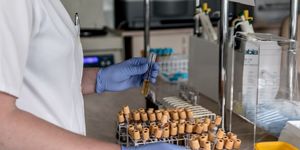The Ingredient That Relieves Your Stomachache Could Also Combat Climate Change
A chemistry team from University of Delaware (UD) reported that they have developed a highly efficient chemical reaction to turn carbon dioxide, the notorious greenhouse gas, into liquid fuels and industrial chemicals. The secret to their success? Bismuth. Yes, the same ingredient in the good old stomach remedy Pepto-Bismol.
The use of the word “bismuth” dates back to the 17th century. The metal element is one of the first ten metals to have been discovered. It was also confused with tin and lead, because of its resemblance in mass and appearance to those two neighbors on the periodic table.
In organometallic chemistry, scientists often use precious metal catalysts such as gold, and silver to reduce carbon dioxide to carbon monoxide and many other small carbon-based molecules.
Joel Rosenthal, a professor of chemistry at UD, pioneered the use of a less expensive metal-bismuth as a catalyst. This humble material is at least fifty times cheaper than silver and thousands times cheaper than gold.
What’s more, the Rosenthal group also managed to use bismuth as the only catalyst to promote multiple steps of the reaction, which is usually done separately in different conditions and with various catalysts.
Commenting on their discovery, Rosenthal said in a news release: “I've been fascinated by the field of catalysis for a long time. Thinking about how you can take something cheap and plentiful and convert it into something much more useful and valuable without having to dump a lot of extra energy into it has always captured my imagination.”
Will this bismuth-catalyzed reaction be used to lower the current carbon dioxide levels?
"It's hard to predict the direct impact on those levels," he said. But Rosenthal is optimistic: "This technology would allow us to make liquid fuels using renewable electricity from sunlight and wind. This, in turn, would decrease our need for conventional petroleum resources, resulting in fewer carbon dioxide emissions."
This study was published in the journal ACS Catalysis.
Catalytic plasticity: A new way to draw down carbon dioxide? (University of Delaware)
Source: phys.org/University of Delaware









